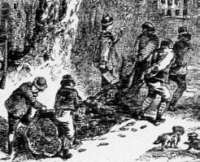
[Excerpted from Clement A. Miles' Christmas in Ritual and Tradition, Christian and Pagan (1912).]
The names given to the Christmas feast by different European peoples throw a certain amount of light on its history. Let us take five of them - Christmas, Weihnacht, Noël, Calendas, and Yule - and see what they suggest.
I. The English Christmas and its Dutch equivalent Kerstmisse, plainly point to the ecclesiastical side of the festival; the German Weihnacht (sacred night) is vaguer, and might well be either pagan or Christian; in point of fact it seems to be Christian, since it does not appear till the year 1000, when the Faith was well established in Germany. Christmas and Weihnacht, then, may stand for the distinctively Christian festival.
II. The French Noël is a name concerning whose origin there has been considerable dispute; there can, however, be little doubt that it is the same word as the Provencal Nadau or Nadal,the Italian Natale, and the Welsh Nadolig, all obviously derived from the Latin natalis, and meaning "birthday." One naturally takes this as referring to the Birth of Christ, but it may at any rate remind us of another birthday celebrated on the same date by the Romans of the Empire, that of the unconquered Sun, who on December 25th, the winter solstice according to the Julian calendar, began to rise to new vigor after his autumnal decline.
III. The Provencal Calendas or Calenos, the Polish Kolenda, the Russian Kolydda, the Czech Koteda and the Lithuanian Kalledos, not to speak of the Welsh Nos Calen for New Year's eve, and the Gaelic Calluinn for New Year's Eve, are all derived from the Latin Kalendae, and suggest the connection of Christmas with the Roman New Year's Day, the Kalends or the first day of January, a time celebrated with many festive customs. What these were, and how they have affected Christmas we shall see in some detail; suffice it to say here that the festival, which lasted for at least three days, was one of riotous life, of banqueting and games and license. It was preceded, moreover, by the Saturnalia (December 17 to 23) which had many like features, and must have formed practically one festive season with it. The word Saturnalia has become so familiar in modern usage as to suggest sufficiently the character of the festival for which it stands.
IV. One more name yet remains to be considered, Yule (Danish Jul), the ordinary word for Christmas in the Scandinavian languages, and not extinct among ourselves. Its derivation has been widely discussed, but so far no satisfactory explanation of it has been found. Professor Skeat in the last edition of his Etymological Dictionary (1910) has to admit that origin is unknown. Whatever its source may be, it is clearly name of a Germanic season - probably a two-month tide covering the second half of November, the whole of December, and the first half of January. It may well suggest to us the element added to Christmas by the barbarian peoples who began to learn Christianity about the time when the festival was founded. Modern research has tended to disprove the idea that the old Germans held a Yule feast at the winter solstice, and it is probable, as we shall see, that the specifically Teutonic Christmas customs come from a New Year and beginning-of-winter festival kept about the middle of November. These customs transferred to Christmas are to a great extent religious or magical rites intended to secure prosperity during the coming year, and there is also the familiar Christmas feasting, apparently derived in part from the sacrificial banquets that marked the beginning of winter.
Copyright © D. J.McAdam· All Rights Reserved